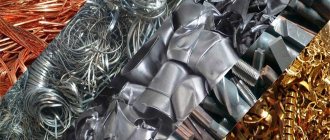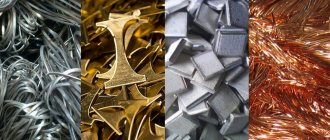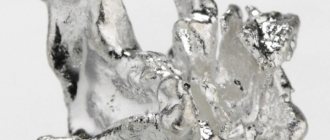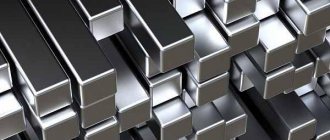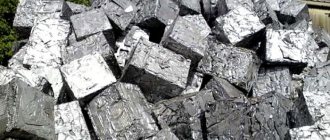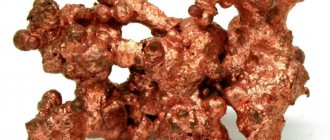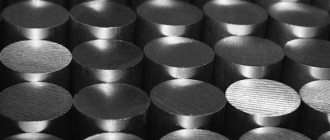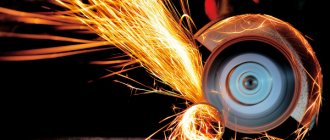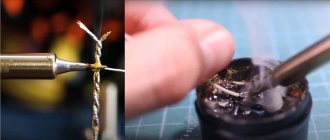Non-ferrous metals are those that do not contain natural iron.
This is a group of elements of heterogeneous quality, which received a general name because of the striking color of copper - the most common of them. Scrap metal collection points of interest to:
- the metals themselves;
- scrap;
- alloys.
If this material is not reused, taken from used household items and equipment, and new ones are mined each time, then the planet’s mineral resources will soon be depleted.
Sorting non-ferrous metal
Non-ferrous metals and alloys are divided into groups on several grounds:
- Heavy: copper, tin, mercury, lead, zinc.
- Lightweight: aluminum, beryllium, calcium, magnesium.
- Noble: gold, silver, platinum, palladium, radium, ruthenium, iridium, osmium.
- Rare: vanadium, tungsten, molybdenum, radium, tantalum, chromium, etc.
- Refractory: vanadium, tungsten, manganese, molybdenum, titanium, chromium.
There are much more metal alloys in various combinations and proportions . Then the resulting material acquires the necessary properties for use in sectors of the national economy.
Scrap metal from non-ferrous metals and alloys is also usually classified :
- By type of predominant metal: copper scrap and copper alloy scrap, aluminum, magnesium, titanium, lead, rare metal scrap, semiconductor, precious.
- According to physical indicators, scrap is divided into classes;
- According to the chemical composition - on the brand.
- In terms of quality - by variety.
In metallurgy they are sorted depending on:
- characteristic properties;
- meanings.
The scale of importance for the industrial production of common metals and alloys is built as follows:
- aluminum and aluminum alloys;
- copper and copper-nickel alloys;
- bronze and tin bronzes;
- magnesium;
- nickel;
- titanium;
- tin;
- lead;
- zinc.
At collection points they readily take any non-ferrous metal. The championship rightfully belongs to aluminum , or more precisely, to its alloys. In second place is copper.
Both are used more intensively than others in:
- industrial production;
- construction.
very common .
The electrical conductivity properties of silver are higher, but it is expensive. Therefore, in cables and wires to conduct current, conductors are made from another excellent conductor - copper.
It is actively used in:
- electrical engineering;
- pipe production.
Application
Good mechanical properties, relative cheapness - these advantages ensured constant demand for the former orichalcum.
Brass alloys are used in parts for which the following are important:
- plastic;
- deformability;
- fluidity;
- processing ability.
Modern orichalcum has a pleasant golden color. It is used in the production of accessories, artistic products (cups, badges, insignia, orders and medals).
We recommend: BARIUM - from Chinese blue to fluoroscopy
However, brass is not a precious metal.
- The alloy has found application in the manufacture of pipelines and parts for sea vessels.
- Indispensable in the manufacture of instruments and parts for chemical production.
- Gears, nuts, bushings, bolts - brass is needed everywhere.
- It is used in hydraulic systems of cars, printing matrices, and parts of mechanical watches.
| Double wrought brasses | |
| Brand | Application area |
| L96, L90 | Parts of machines, thermal and chemical equipment, coils, bellows, etc. |
| L85 | Parts of machines, thermal and chemical equipment, coils, bellows, etc. |
| L80 | Parts of machines, thermal and chemical equipment, coils, bellows, etc. |
| L70 | Sleeves for chemical equipment, individual stamped products |
| L68 | Most stamped products |
| L63 | Nuts, bolts, car parts, condenser pipes |
| L60 | Thick-walled pipes, nuts, machine parts. |
| Multi-component wrought brasses | |
| Brand | Application area |
| LA77-2 | Marine condenser pipes |
| LAZ60-1-1 | Details of sea vessels. |
| LAN59-3-2 | Parts of chemical equipment, electrical machines, marine vessels |
| LZhMa59-1-1 | Bearing shells, aircraft and marine parts |
| LN65-5 | Gauge and condenser tubes |
| LMts58- 2 | Nuts, bolts, fittings, machine parts, Soviet small change coin of the 1958 model, in denomination 1-5 kopecks. |
| LMtsA57-3-1 | Details of sea and river vessels |
| LO90-1 | Condenser pipes of heating equipment |
| LO70-1 | Condenser pipes of heating equipment |
| LO62-1 | Condenser pipes of heating equipment |
| LO60-1 | Condenser pipes of heating equipment |
| LS63-3 | Watch parts, bushings |
| LS74-3 | Watch parts, bushings |
| LS64-2 | Printing matrices |
| LS60-1 | Nuts, bolts, gears, bushings |
| LS59-1 | Nuts, bolts, gears, bushings |
| LZhS58-1-1 | Parts made by cutting |
| LK80-3 | Corrosion-resistant machine parts |
| LMsh68-0.05 | Condenser pipes |
| LANKMts75- 2- 2.5- 0.5- 0.5 | Springs, pressure tubes |
Foundry brasses
| Brand | Application area |
| LTs16K4 | Reinforcement parts |
| LTs23A6ZhZMts2 | Solid worm screws, compression screw nuts |
| LCZOAZ | Corrosion-resistant parts |
| LTs40S | Cast fittings, bushings, cages, bearings |
| LTs40MtsZZH | Critical parts operating at temperatures up to 300 °C |
| LTs25S2 | Car hydraulic system fittings |
Jewelry alloys
A brass dice, next to it are zinc and a copper ingot.
| Jewelry alloys | ||
| Type of processing | Color | Alloy name |
| casting | yellow | Brass granules M67/33 |
| casting | green | Brass granules M60/40 |
| casting | gold | Brass granules M75/25 |
| casting | yellow | Brass granules M90 |
We recommend: LEAD - a necessary disease of civilizations
How do non-ferrous metals differ from ferrous metals?
The main difference between ferrous and non-ferrous metals is not the color . Black reacts to a magnet, color does not. But this is not the only feature.
Other features of non-ferrous metal in comparison with its counterpart:
- does not corrode : over time, copper turns green or black, and zinc turns white, but does not lose its fundamental properties;
- highly anti-friction : even under high pressure it strongly resists friction;
- has increased electrical and mechanical resistance ;
- conducts current perfectly ;
- has high heat capacity and thermal conductivity ;
- difficult to paint ;
- creates alloys that are resistant to fire and acid .
Of course, iron and ferroalloys are the leaders in processing. But everything made from non-ferrous metals falls into the high-tech sector .
For example, construction :
- airplanes;
- ships;
- vehicle engines.
And also production :
- computers;
- high-precision equipment.
What does a ligature give?
| Additive | Property |
| Manganese | Improved corrosion resistance and strength |
| Tin | Increases strength, slows down corrosion in seawater |
| Nickel | Improves overall corrosion resistance in aggressive environments |
| Lead | Improves cutting performance, but degrades mechanical properties |
| Silicon | In combination with lead, it increases anti-friction properties |
The content of more than 20% zinc in the solid melt leads to deformation and corrosion spreading. This drawback is corrected by annealing the products at a temperature of 250-300 degrees.
Important: the more zinc in the alloy, the cheaper it is.
Origin of metal waste
Copper is scrap brass and bronze.
The most valuable is electrical :
- transformer buses;
- conductors;
- multi-strand cables.
Scrap metal is sold in the following form :
- not burnt;
- not oxidized;
- without enamel;
- without insulation.
They will also accept it with inclusions, but the acceptance price will decrease .
Tin is much more expensive than copper, but there is less of it.
Contain it:
- bearings;
- white tin food containers;
- solder;
- pipelines.
alloy of tin and lead – babbitt – is one of the most expensive.
Lead is taken in the form of:
- plates;
- cable braid;
- melted down
Taken from:
- batteries;
- typographic font;
- telephone cable.
Titanium sources :
- shut-off valves;
- pipelines.
Aluminum is more readily accepted :
- electrotechnical;
- profile;
- cable;
- food.
Depending on where the metal is mined , the acceptance price varies.
Zinc scrap and the alloy of this metal with aluminum and magnesium are valued three times more than just zinc waste. This alloy is called TsAM . It can be found in large quantities in the car.
Story
Copper is one of the first metals that humanity dealt with. This was facilitated by the advantages: high prevalence, availability, relatively low melting point.
People appreciated the benefits of copper eight thousand years ago.
The Copper Age began immediately after the Stone Age:
- Copper artifacts dug up in the territory of modern Turkey are recognized as the oldest. These are beads and decorative overlays.
- Cutting tools and utensils were made from metal.
- The history of the discovery of copper mines in Rus' begins in the Urals two thousand years before the new era. Then there were the Caucasus, Altai, Siberia.
- Industrial processing using bronze began in the 14th century. Cannons and bells were cast from the alloy.
The Tsar Bell and the Tsar Cannon were cast from bronze.
It is assumed that the metal is named after the island of Cyprus. Copper deposits were discovered here back in the 3rd century BC, and the population mastered copper smelting.
M. Vasmer’s “Etymological Dictionary of the Russian Language” links the origin of the Russian term copper with the ancient German root smid – blacksmith, metal.
Where to get scrap metal for delivery to recycling collection points
First - where not to take it .
Excluded:
- theft;
- analysis of railway structures;
- disassembly of power lines;
- analysis of elevators and similar sources.
It is possible - from industrial waste .
From used and declared unusable equipment.
Household scrap metal is found in landfills .
All metal is collected, then cut and sorted .
At the final stage, non-ferrous metal is divided into its component spectrum of metals and alloys.
The easiest material to find is household aluminum.
After all, there are a lot of products made from it:
- fencing;
- floors in construction;
- dishes and containers for liquids;
- Houseware.
A small amount of aluminum—approximately 100 grams—is found in tube TVs . But in this device they find up to 1.5 kg of copper.
Copper can also be found in:
- various transformers;
- installation wires;
- power supplies;
- demagnetization coils.
Radio components contain precious metals. Of course, in minimal quantities.
Up to 1200 grams of copper can be found in refrigerator compressors of previous generations.
Many collectors, without “getting to the bottom” of it, hand over old refrigerators like ferrous metal. Those who get to copper get good money .
In addition to the compressor, the source of copper in an old refrigerator can be kilogram radiators made of copper tubes. And the freezer will store up to two kilograms of aluminum.
Copper will definitely be found in electric motors . A kilowatt of power provides up to a kilogram of red metal.
It is present in automobile starters and generators .
The content of non-ferrous metals in cars is not limited to starters and alternators.
The source of copper is also the chokes of fluorescent lamps , approximately 200 grams in one.
As well as transformers of radio-electronic equipment and magnetic starters having:
- copper winding;
- copper tires.
Lead contains:
- batteries;
- cable braids.
Sources of brass and bronze :
- water taps;
- valves;
- shower tubes and hoses;
- reduction gears;
- wire.
If you disassemble the piano , you can scrap the cast iron frame. But is there any non-ferrous metal in the piano? There are strings , but they will only pull a maximum of 100 grams.
Alloys
The range of copper alloys with other components includes dozens of items.
Copper alloys and their applications
They are used more often than pure metal because they reduce the disadvantages inherent in pure metal. That is, they make the product stronger, more stable, and cheaper.
Copper connections are divided into two groups:
- Bronze - with tin.
- Brass – with zinc.
In addition to these main alloying components, the compound contains aluminum, nickel, bismuth, titanium, silver, gold, and non-metallic elements.
Popularity rating of recyclable materials
The most expensive non-ferrous metal waste is tungsten . They give about a thousand rubles per kilogram for it.
Babbitt (an alloy of lead and tin) will enrich the deliverer by 900 rubles. per kilogram.
For 50 rubles. they will pay less for molybdenum . You can get 550 rubles for nickel, 400 for nichrome .
Of the common non-ferrous metal options, the most valuable is copper , 250-280 rubles/kg.
Large collection points have a non-ferrous metal calculator on their website. Here you can find out the value of your metal without leaving your home.
Copper in nature
In nature, two manifestations of the element have been identified - nuggets and components of compounds with other elements.
Copper nugget
Most often these are compounds: oxides, sulfides, bicarbonates. The most common raw material is copper pyrite.
Copper gives deep blue, cyan, greenish shades to malachite, turquoise, chrysocolla, and other minerals of the jewelry and decorative segment.
Why recycle scrap metal?
Recycling is important for:
- economics;
- ecology.
For a long time it was believed that the planet's mineral resources were limitless .
In fact, many of them are close to exhaustion.
Metal ore is from this category.
Industrialization , which continues to accelerate, requires more metal for industrial use.
Recycling various metal products gives the material a second, or even a third, life. Recycling of metal recyclables has existed in the world for more than a hundred years .
Scrap metal is accepted at special points and sent to metallurgical plants.
After melting, recyclable materials do not lose their properties and are thus reused many times.
Repeated use of non-ferrous scrap metal is much more economical and safer for the environment than extracting it from the ground.
Metals are not found in nature in their pure form; ore contains a lot of waste rock and impurities (up to 95 percent). To extract, for example, copper from ore, you need to spend a lot of energy .
It is difficult and expensive to separate this or that non-ferrous metal from alloys, which is done in processing plants. But this process is also more economically profitable than ore mining.
The difference in price is explained by the fact that it is not necessary:
- develop a deposit;
- process ore;
- concentrate.
The main advantages of recycling recyclable materials:
- Severely depleted deposits of metal ores are “resting”;
- fuel required for extraction and processing is saved;
- ecology is preserved;
- There is less metal sputtering and scattering.
Some types of non-ferrous metal are harmful to the environment when released into:
- soil;
- water.
To prevent accumulations of waste metal, and to put waste into use means taking care of:
- nature;
- health of compatriots.
This point is also important: by clearing the Earth of rubbish in the form of scrap metal, collectors earn money.
And in the case of non-ferrous metals, they earn good money.
Arguments for selling scrap metal:
- scrap metal prices are rising;
- the range of in-demand scrap metal is expanding ;
- cutting is carried out by numerous receiving points.
Nickel and cobalt
Nickel and cobalt , also elements of the iron family, are more common in mafic and ultramafic rocks, especially nickel.
Nickel ores
It forms large deposits in South-West Africa, on the Kola Peninsula and in the Norilsk region. These are igneous deposits. Nickel sulfides crystallized from magmatic melt coming from the mantle or from hot aqueous solutions. A special type is represented by residual nickel deposits, formed as a result of weathering of nickel-bearing basic rocks, such as basalts and gabbroids.
In this case, oxidized nickel minerals appear in the form of loose greenish masses. These same residual nickel ores are enriched with iron, which allows them to be used for the manufacture of iron-nickel alloys. Such deposits are found in the Urals, but they are especially widespread in the tropical zone - on the islands of Indonesia and the Philippines, where intensive oxidation of rocks on the surface occurs.
conclusions
Any state is interested in collecting and processing scrap metal. Both in environmental and economic aspects.
Mineral deposits are decreasing in size, new resources . The main one is to use recycled non-ferrous metals.
Recycled non-ferrous metal is used in the form of alloys, which are urgently needed by modern industry . And the collectors receive income. Therefore, you can develop a good business in non-ferrous metals. So everyone wins.

